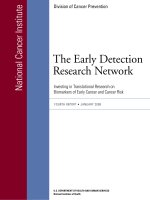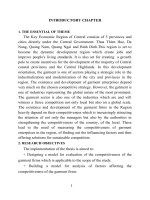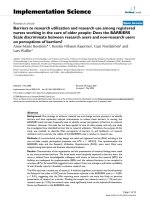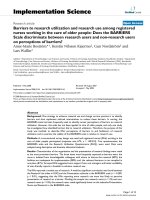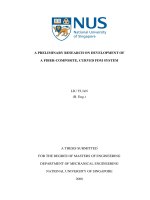Research on competitiveness of garment firms in the key economic zone of central
Bạn đang xem bản rút gọn của tài liệu. Xem và tải ngay bản đầy đủ của tài liệu tại đây (116.81 KB, 61 trang )
MINISTRY OF EDUCATION AND TRAINING
UNIVERSTY OF DA NANG
---------------------VO THI QUYNH NGA
RESEARCH ON COMPETITIVENESS
OF GARMENT FIRMS IN THE KEY ECONOMIC ZONE
OF CENTRAL
MAJOR: INDUSTRIAL ECONOMY
CODE: 62.31.09.01
SUMMARY OF PH.D THESIS ON ECONOMICS
Danang - 2014
THESIS IS DONE AT
University of Economics, University of Da Nang
Thesis advisors: Assoc. Prof. Dr. Nguyen Truong Son
Doan Gia Dung, Ph.D.
Reviewer 1: Prof. Dr. Hoang Ngoc Viet
Reviewer 2: Assoc. Prof. Dr. Tran Van Hoa
Reviewer 3: Do Thi Thanh Vinh, Ph.D.
The thesis will be presented before the Thesis Commitee at the
University of Da Nang..
In .. date .......... month .......... ......... 2014
Thesis can be found at:
LIST OF AUTHOR’S PUBLISHED
SCIENTIFIC WORKS
1. Vo Thi Quynh Nga (2012), The impact of the global financial
crisis (2008-2009) on the global garment value chain, Research
project managed by Danang University, accepted on 28/12/2012
2. Vo Thi Quynh Nga (2013), The impact of the global financial
crisis (2008-2009) on the global garment value chain, Journal of
Science and Technology University of Da Nang, No 65, April, p.
79-86
3. Vo Thi Quynh Nga (2013), Competitiveness on financial aspects
of apparel firms in the Key Economic Zone of Central and the role
of the banking system, Journal of Science and Technology
University of Da Nang, No 68, July, 134-141
4. Doan Gia Dung – Vo Thi Quynh Nga (2013), About upgrading
the value chains of garment firms in the Key Economic Region of
Central, Conference on Management Science, July 2013, p. 84-92
5. Vo Thi Quynh Nga, Nguyen Truong Son (2013), Designing
applied model in measuring competitiveness of garment firms in
the Key Economic Region of Central, Journal of Economics and
Development, No 198, December 2013, p. 60-70
24
+ A explanatory model is modified in accordance with the research
context in the Key Economic Zone of Central
+ A new approach in the assessment of the competitiveness of
garment enterprises in the Key Economic Zone of Central: assessment
not only based on representative data of the group but also on individual
elements of the firms
+ Suggestion of garment manufacturing modes consistent with the
target market and characteristics of enterprise resources.
+ Solutions for development of support industry towards selective
industry and provinces.
4. The new research orientations
+ Expand the comparison subjects.
+ Research of influence of garment manufacturing model on
competitiveness of the garment business groups with different sizes.
+ Research of influence of garment manufacturing model on
competitiveness of the garment business groups on different markets.
1
INTRODUCTORY CHAPTER
1. THE ESSENTIAL OF THEME
The Key Economic Region of Central consists of 5 provinces and
cities directly under the Central Government: Thua Thien Hue, Da
Nang, Quang Nam, Quang Ngai and Binh Dinh.This region is set to
become the dynamic development region which create jobs and
improve people's living standards. It is also set for creating a growth
pole to create incentives for the development of the majority of Central
coastal provinces and the Central Highlands. In this development
orientation, the garment is one of sectors playing a strategic role in the
industrialization and modernization of the city and provinces in the
region. The existence and development of garment enterprises depend
very much on the chosen competitive strategy. However, the garment is
one of industries representing the global nature of the most prominent.
The garment sector is also one of the industries which are and will
witness a fierce competition not only local but also on a global scale.
The existence and development of the garment firms in the Region
heavily depend on their competitiveness which is increasingly attracting
the attention of not only the managers but also by the authorities in
strengthening the competitiveness of the country, of the local. These
lead to the need of measuring the competitiveness of garment
enterprises in the region, of finding out the influencing factors and then
offering solutions for sustainable competition.
2. RESEARCH OBJECTIVES
The implementation of the thesis is aimed to:
+ Designing a model for evaluation of the competitiveness of the
garment firms which is applicable to the scope of the study.
+ Building a model for analysis of factors affecting the
competitiveness of the garment firms
2
+ Identifying the current and predictable status of the
competitiveness of garment enterprises in the region when compared
with each other and with garment firms outside of the region.
+ Verifying the influence of factors, both inside and outside of the
firm, to the competitiveness of the garment firrms of the Key Economic
Region of Central.
+ Suggesting a system of appropriate solutions to maintain and
improve competitiveness for these garment frms.
3. OBJECTS AND SCOPE OF THE STUDY
+ Research objects: competitiveness of garment enterprises
+ Scope of Research:
Regarding content: evaluate the competitiveness of garment firms in
The Key Economic Zone of Central; analyze explanatory factors of
garment firms competitiveness and propose a system of solutions to
maintenance and improve the competitiveness of garment enterprises in
The Key Economic Zone of Central.
Regarding the research object: the sewing businesses whose
products are mainly clothing (industry code is 14100).
On the spatial scale: the headquarters of the garment firms are in The
Key Economic Zone of Central. In term of market, the spatial scale will
cover both domestic and foreign markets.
About time range: As usual, the 2012 data will not be available
before August 2013, so data range handled is only until 2011.
4. RESEARCH METHODS
The thesis is done in mixed methods: combining qualitative and
quantitative.
+ Qualitative Method: Theoretical background research and
interviews with experts
23
CONCLUSION
With all the contents have been presented above, the thesis
achievements can be summarized as follows:
1. The results of the thesis
Compared with the objectives of the thesis, research project has
achieved the following results:
+ A relatively complete theoretical background of competitiveness,
including research perspective of competitiveness, the inner meaning of
the competitiveness concept; models for research of competitiveness at
the firm level of and theoretical background of apparel industry.
+ A distinctive theoretical model to assess competitiveness and
analyze the factors affecting the competitiveness of garment enterprises.
+ A model of competitiveness research (evaluation and factor
analysis) have applicability in the research context of the Key
Economic Zone of Central with a big number of studied and refenced
objects.
+ A relatively systematic evaluation for competitiveness of garment
enterprises in the region.
+ A detailed analysis of the relative influence of the factors groups
on the competitiveness of the garment enterprises in the region; the
original factor are tested.
+ A system of solutions can be applied at the enterprise level and at
the macro level with many new features such as choice of apparel
production modes, development of selectively support industry ...
2. New research results
+ Theoretical models for evaluation and for explanation of garment
enterprises competitiveness in particular economic zones
22
Increasing ability to provide information on new materials, to
participate in design activities, to consult fashion trends, to undertake
logistic activities of input and output, quality control...
3.4.1.7. Some other solutions:
* Achieving certification agaisnt international standards to improve
the confidence of buyers
* Orientation towards environmental protection in production
3.4.2. The solutions at the macro level
3.4.2.1. Development of selective support industries
+ Industrial orientation: towards the industries not requiring
complicated technology, less environmental pollution (sewing, buttons,
lace ..)
+ Local orientation: not investing in the 5-scattered localities in the
region; not investing in the dyeing industry in Danang and Quang Nam
because of the risk of sea pollution; this industry can be invested in
Thua Thien Hue.
3.4.2.2. Strengthen state management and businesses support
functions
Strengthening the role of the authorities and of fuctional
management bodies in implementing government policy on small and
medium garment enterprises, human resource training in sewing, trade
promotion for garment industry , providing market information,
certification of origin, anti counterfeit ...
3.4.2.3. Enhancing intra-regional cooperation in the development
of the garment industry
The viewpoint is that provinces and city in the regiong exploit
together comparative advantage of localities in the region. Orientation
of intra-local cooperation: at the corporate level (sharing orders,
marketing collaboration, collaborative training ...) and at the local level
(discussion in the planning sector, collaboration in organinsing
industrial fairs, in promoting trade..)
3
+ Quantitative Methods: descriptive statistics, index, ANOVA on Excel
5. EXPECTED RESULTS
The thesis is expected to achieve the following results:
+ A relatively completed theoretical background of competitiveness
+ A evaluation model and a explanatory model of garment firms
competitiveness of enterprises which are applicable in a specific research
context: the Key Economic Region of Central.
+ Assessment results of competitiveness of garment firms in the Key
Economic Region of Central.
+ Analysis findings of influences of factors on the competitiveness of
the garment firms of the Key Economic Region of Central.
+ A number of proposals at the micro level and macro level in order to
improve the competitiveness of garment firms of the Key Economic
Region Central
6. OVERVIEW OF RESEARCH
+ The levels of competitiveness rechearchs
+ The points on competitiveness research
+ The main research directions of competitiveness
+ The main research directions of competitiveness in the garment
industry
+ Theoretical background has been applied in the studies of the
garment industry competitiveness
+ The research methods and results
4
CHAPTER 1
THEORETICAL AND PRACTICAL BACKGROUND OF
ESTABLISHING MODELS FOR STUDYING
COMPETITIVENESS OF GARMENT FIRMS
1.1. FIRM COMPETITIVENESS
1.1.1. The concepts of firm competitiveness
In this section, many competitiveness concepts are introduced. These
are concepts which are often cited, referenced in a lot of
competitiveness researches works, including the concept of the report
on the oversea trade activities in some branch of Loyds (1985), of
D'Cruz and Rugman (1992), of Markusen (1992), of the European
Community Europe (1993), of the White Paper on competitiveness of
the UK (1994 ), of Chickan (2001), of the Asian Development Outlook
(2003), of Vu Trong Lam (2006).
1.1.2. Characteristics of competitiveness
In addition to the multi-level attribute of competitiveness concept,
this concept has also additional connotation such as multi-defined,
multi-measured, dependent, relative and dynamic.
1.1.3. The concept of firm competitiveness of the thesis
With a Performance viewpoint, inheriting the spirit of the precede
research on competitiveness, in this thesis, competitiveness is the ability
of firms in dealing with competition to maintain and enhance the value
of the firm.
1.2. MODELS FOR STUDYING FIRM COMPETITIVENESS
1.2.1. An overview of the competitiveness research models
+ In term of level of competitiveness: there are models for studying
national competitiveness, industrial competitiveness and corporational
competitiveness.
21
3.4. SOLUTIONS OF ENHANCING COMPETITIVENESS OF GARMENT
FIRMS IN THE KEY ECONOMIC REGION OF CENTRAL
3.4.1. Solutions at firm level
3.4.1.1. Diversifying markets and products
Based on the analysis of the market prospects, this solution indicates
some markets in which, garment firms in the region can exploit, as well
as some lines of specialty products can be developed corresponding to
each target market.
3.4.1.2. Selecting the suitable mode of garment manufacturing
This solution suggests a number of directions in the selection
garment manufacturing modes corresponding behavioral characteristics
of the buyers in the target market as well as the resources of the
company
3.4.1.3. Keeping in consolidating the cost advantage
This solution includes proposals to reduce costs, such as
identification and mitigation of activities which do not create value,
innovation of production methods and organization of garment
production, renovation of garment production equipment,
computerization of the operations, and improvement of labor
productivity
3.4.1.4. Increasing the perceived value of the products
This solution aims to increase the perceived value of the products of
garment enterprises in the region through intensive investment into
designing to provide truly unique and innovative designs; through
selection of valuable materials; through enhancing brand promotion
activities in specific activities such as fashion shows, participation in
industrial fairs
3.4.1.5. Reducing lead time
Garment firms can shorten lead time through proactive early offers,
sharing orders, materials sources control right after offers, planing and
serious control of plan implementation...
3.4.1.6. Developing the ability to provide full service
20
T
H
R
E
A
T
S
(
T
)
T
1.
M
or
e
an
d
m
or
e
co
m
pe
ti
to
rs
T
2.
S
tr
in
ge
nt
r
eq
ui
re
m
en
ts
o
n
th
e
or
ig
in
o
f
go
od
s
T
3.
M
or
e
an
d
m
or
e
of
co
un
te
rf
ei
t
go
od
s,
pi
ra
te
d
go
od
s
T
4.
L
ab
or
c
os
ts
i
nc
re
as
ed
d
ue
to
m
an
y
re
as
on
s
T
5.
T
he
em
er
ge
nc
e
of
te
ch
ni
ca
l
ba
rr
ie
rs
in
th
e
bi
g
m
ar
ke
ts
S
-T
1)
S
1
S
2
T
1
W
-T
1)
W
8
T
2
2)
W
4
T
5
O
P
P
O
R
T
U
N
IT
IE
S
(O
)
O
1.
B
ec
om
in
g
on
e
of
te
xt
il
e
ce
nt
er
s
of
t
he
co
un
tr
y
O
2.
T
he
g
ov
er
nm
en
t's
s
up
po
rt
O
3.
T
he
g
ov
er
nm
en
t
in
ce
nt
iv
es
f
or
s
m
al
la
nd
m
ed
iu
m
-s
ca
le
d
ga
rm
en
t
fi
rm
s
O
4.
T
he
e
xp
an
si
on
o
f
m
ar
ke
ts
O
5.
I
nc
re
as
in
g
de
m
an
d
of
d
om
es
ti
c
m
ar
ke
t
O
6.
T
he
s
ig
ni
ng
o
f
th
e
tr
ad
e
ag
re
em
en
ts
O
7.
F
or
ei
gn
i
nv
es
tm
en
t
fl
ow
s
in
to
pr
od
uc
ti
on
of
g
ar
m
en
t
m
at
er
ia
ls
a
nd
a
cc
es
so
ri
es
O
8.
T
he
U
.S
.
an
d
E
U
im
po
rt
er
s'
sw
it
ch
to
su
pp
li
er
s
ou
ts
id
e
C
hi
na
O
9.
T
he
d
ev
el
op
m
en
t
of
S
ou
rc
e
A
S
E
